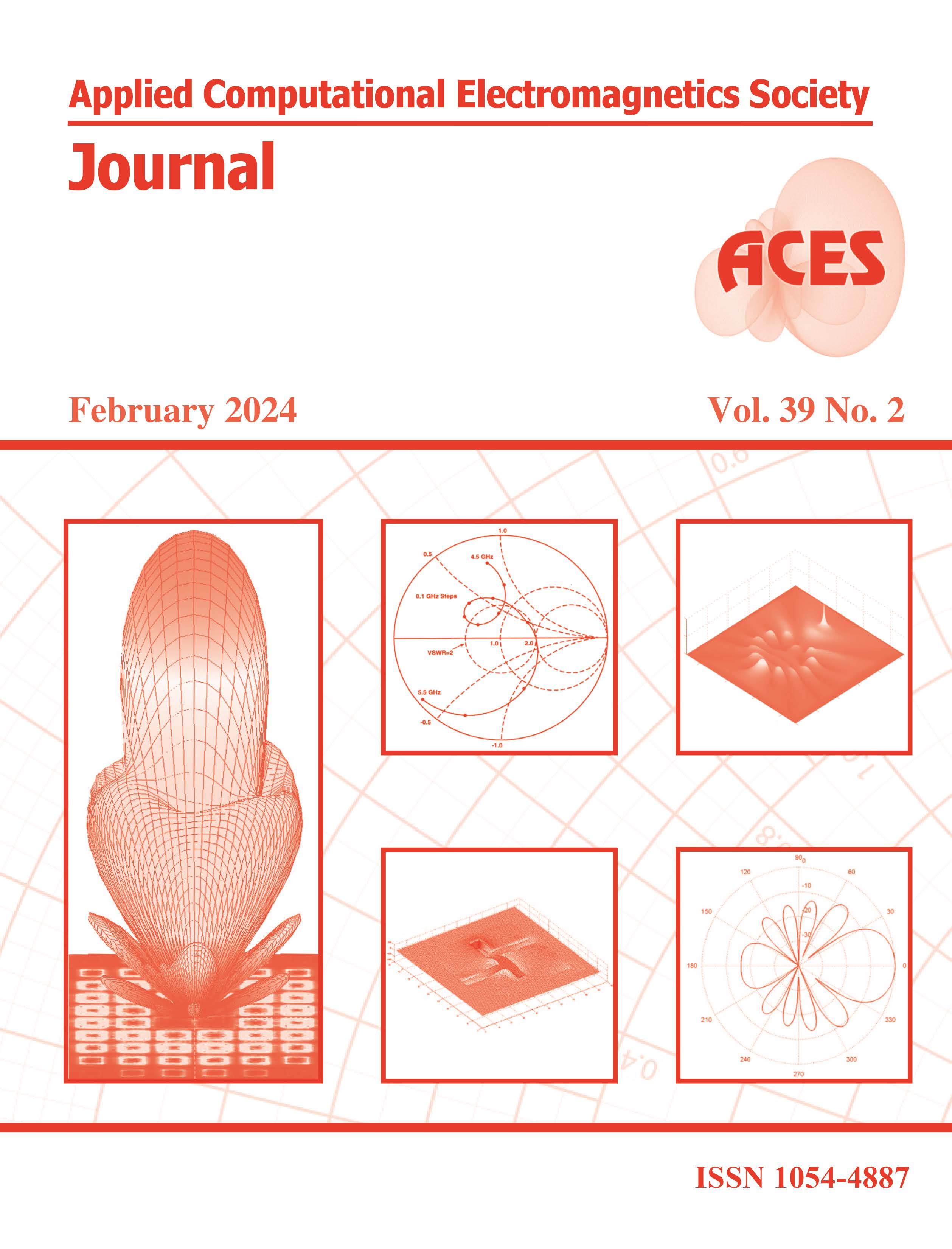A Numerical Analysis of Conformal Energy Selective Surface Array with Synthetic Functions Expansion
DOI:
https://doi.org/10.13052/2024.ACES.J.390204Keywords:
Energy selective surface (ESS), large-scale arrays, metasurface, method of moment (MoM), synthetic functions expansion (SFX)Abstract
Energy selective surface (ESS) is a special kind of metasurface with great potential in high-power microwave protection. In this paper, the electromagnetic (EM) properties of an ESS array are analyzed with synthetic functions expansion (SFX) method. A cylindrical conformal ESS array based on an I-shape element is designed for demonstration. The Bistatic RCS as well as electric field distribution of the ESS array is calculated with SFX and traditional full-wave numerical methods. The results show that SFX exhibits great advantages in memory cost while maintaining the same level of accuracy and efficiency with the multi-layer fast multipole method (MLFMM). Besides, the EM performance of the designed ESS is calculated with an array with finite elements and unit cell with periodic boundaries, respectively. The results show a good agreement. The proposed method can also be applied to the analysis of other kinds of metasurfaces whose elements share similar geometries with periodic or quasi-periodic arrangement. Especially for large-scale arrays, this method could well overcome the difficulty of balancing accuracy, efficiency, and resource consumption.
Downloads
References
P. Liu, C. Liu, J. Tan, Y. Dong, and B. Yi, “Analysis of the research development on HPM/EMP protection,” Chinese Journal of Ship Research, vol. 10, no. 2, pp. 2-6, 2015 [in Chinese].
C. Yang, P. Liu, and X. Huang, “A novel method of energy selective surface for adaptive HPM/EMP protection,” IEEE Antennas Wireless Propag. Lett., vol. 12, pp. 112-115, 2013.
N. Hu, Y. Zhao, J. Zhang, P. Liu, H. Xu, and F. Costa, ”High-performance energy selective surface based on equivalent circuit design approach,” IEEE Trans. Antennas Propag., vol. 70, no. 6, pp. 4526-4538, 2022.
N. Hu, K. Wang, J. H. Zhang, S. Zha, Z. F. Wu, C. Liu, and P. Liu, “Design of ultrawideband energy-selective surface for high-power microwave protection,” IEEE Antennas Wireless Propag. Lett., vol. 18, no. 4, pp. 669-673, 2019.
N. Hu, S. Zha, T. Tian, and P. Liu, “Design and analysis of multiband energy selective surface based on semiconductors,” IEEE Trans. Electromagn. Compat., vol. 64, no. 4, pp. 1076-1085, 2022.
Z. Wu, Y. Xu, P. Liu, T. Tian, and M Lin, “An ultra-broadband energy selective surface design method: From filter circuits to metamaterials,” IEEE Trans. Antennas Propag., vol. 71, no. 7, pp. 5865-5873, 2023.
W. Kui, X. Huang, T. Tian, W. Huang, and P. Liu, -1447283793-1447283793“Design and demonstration of high-power density infrared nonlinear filtering window with EM shielding,” Opt. Express., vol. 32, pp. 5956-5968, 2024.
T. Tian, X. Huang, Y. Xu, P. Liu, C. Liu, N. Hu, J. Zhang, and Z. Wu, “A wideband energy selective surface with quasi-elliptic bandpass response and high-power microwave shielding,” IEEE Trans. Electromagn. Compat., vol. 61, no. 1, pp. 224-233, 2024.
L. Tarricone, “A genetic approach for the efficient numerical analysis of microwave circuits,” Applied Computational Electromagnetics Society (ACES) Journal, vol. 1, no. 1, pp. 87-93, 2000.
Z. Jiang, Y. Sha, X. Xuan, and L. Nie, “An omnidirectional antenna with multi-taper conformal structure,” Applied Computational Electromagnetics Society (ACES) Journal, vol. 38, no. 3, pp. 184-192, 2023.
G. Sener, “Antenna synthesis by Levin’s method using a novel optimization algorithm for knot placement,” Applied Computational Electromagnetics Society (ACES) Journal, vol. 38, no. 7, pp. 482-488, 2023.
Y. Xu, X. Huang, C. Liu, S. Zha, and J. Liu, “Synthetic functions expansion: Automation, reuse, and parallel,” IEEE Trans. Antennas Propag., vol. 69, no. 3, pp. 1825-1830, 2021.
L. Matekovits, G. Vecchi, G. Dassano, and M. Orefice, “Synthetic function analysis of large printed structures: The solution space sampling approach,” Proc. IEEE AP-S Int. Symp., Boston, MA, pp. 568-571, 2001.
L. Matekovits, V. A. Laza, and G. Vecchi, “Analysis of large complex structures with the synthetic-functions approach,” IEEE Trans. Antennas Propag., vol. 55, no. 3, pp. 2509-2521, 2007.
W. C. Chen, G. B. Xiao, S. Xiang, and J. F. Mao. “A note on the construction of synthetic basis functions for antenna arrays,” IEEE Trans. Antennas Propag., vol. 60, no. 7, pp. 3509-3512, 2012.
Y. L. Xu, H. Yang, W. K. Yu, and J. Zhu. “An automatic scheme for synthetic basis functions method,” IEEE Trans. Antennas Propag., vol. 66, no. 3, pp. 1601-1606, 2018.
B. Zhang, G. B. Xiao, J. Mao, and Y. Wang, “Analyzing large-scale non-periodic arrays with synthetic basis functions,” IEEE Trans. Antennas Propag., vol. 58, no. 11, pp. 3576-3584, 2010.
L. Matekovits, G. Vecchi, M. Bercigli, and M. Bandinelli, “Synthetic-functions analysis of large aperture-coupled antennas,” IEEE Trans. Antennas Propag., vol. 57, no. 7, pp. 1936-1943, 2009.
Y. L. Xu, H. Yang, D. Peng, and R. J. Shen, “Efficient numerical analysis of dielectric resonator antenna arrays,” IEEE Antennas Wireless Propag. Lett., vol. 27, no. 4, pp. 670-674, 2018.




